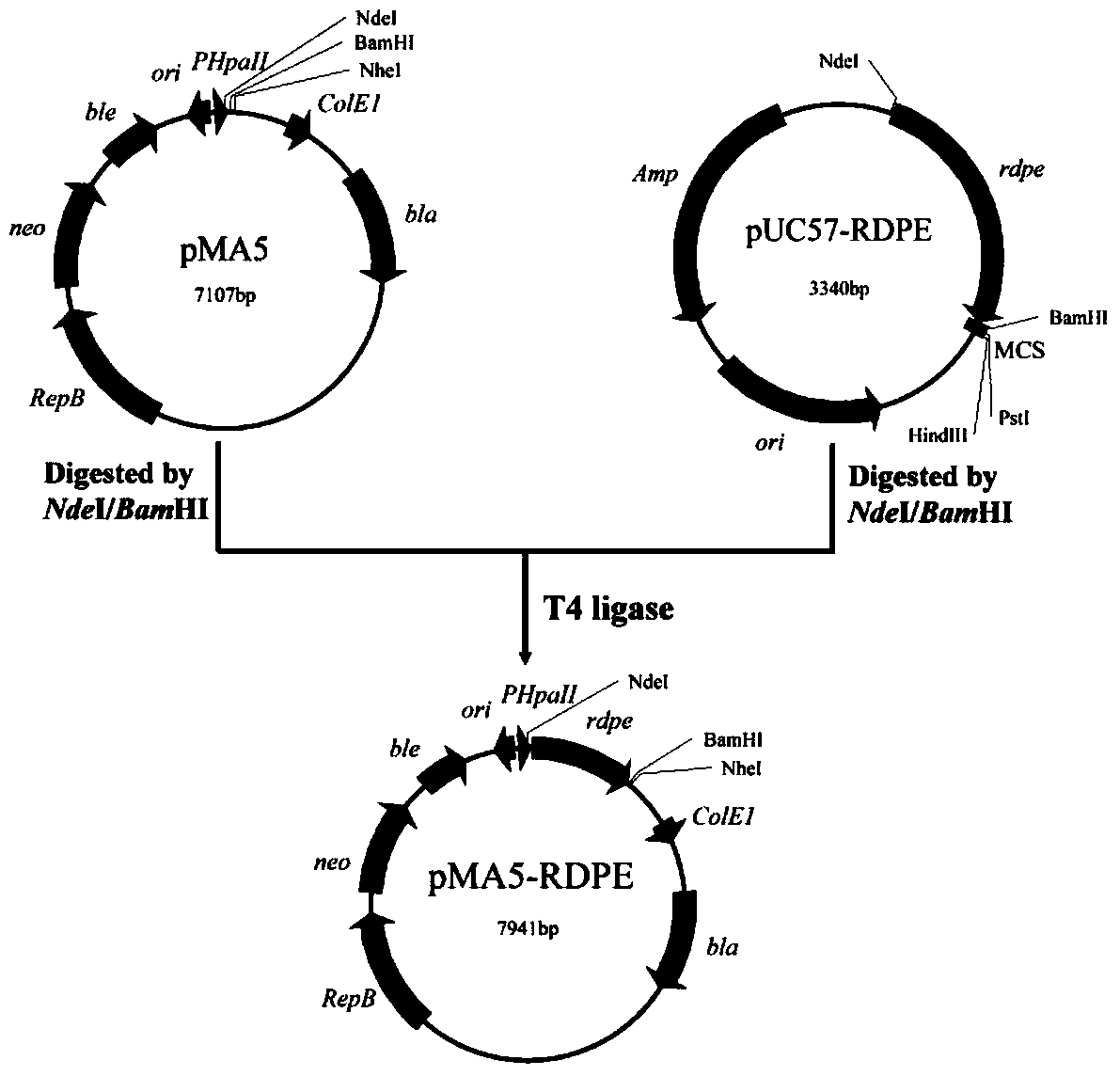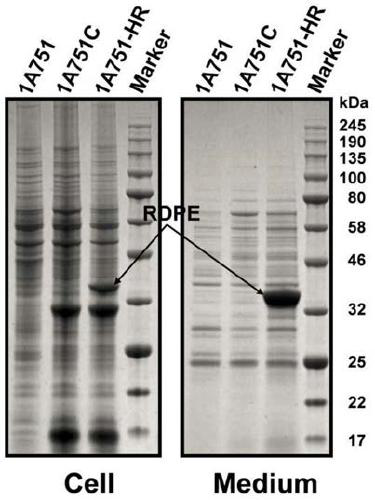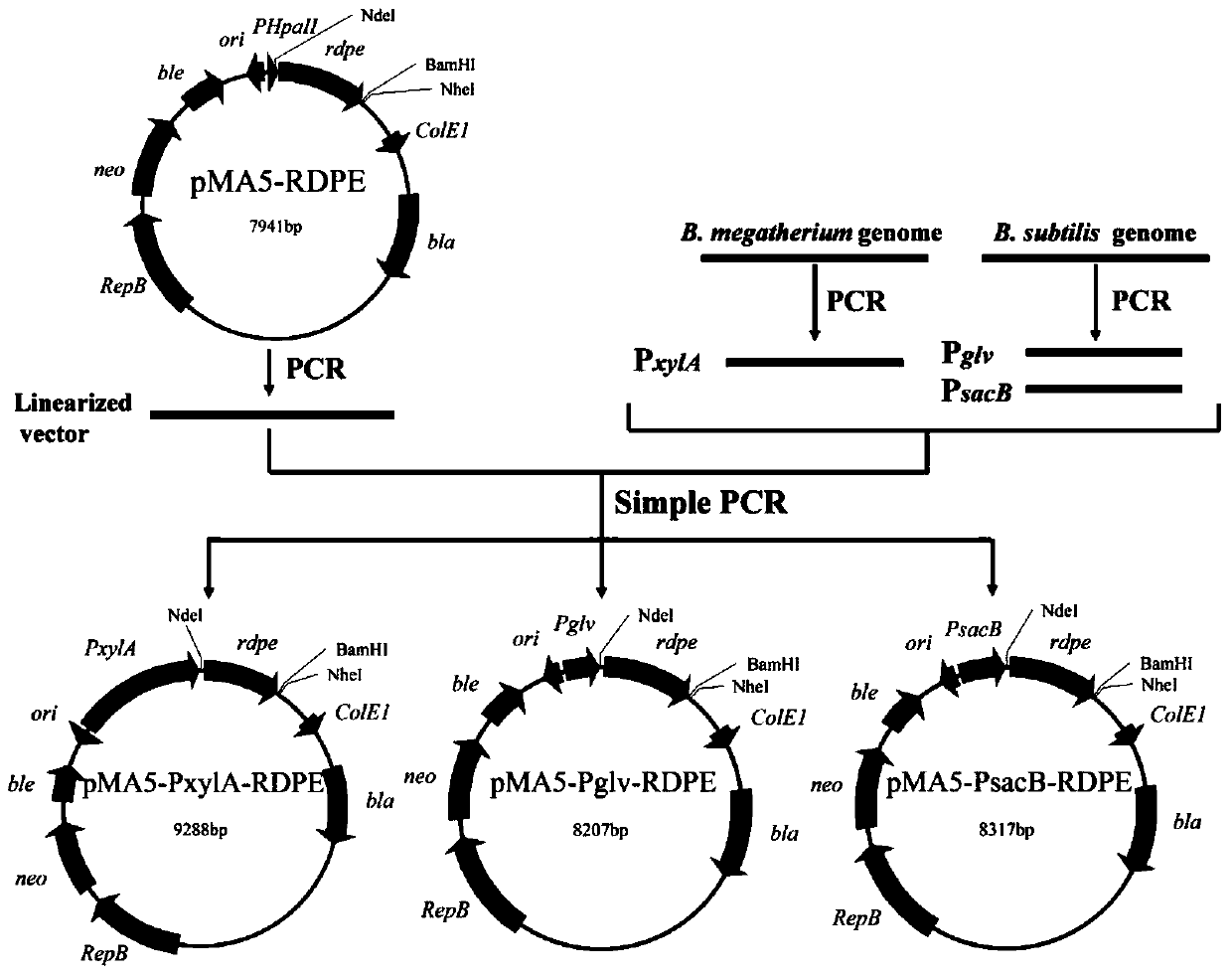A genetically engineered strain for efficiently secreting d-psicose 3-epimerase, its construction method and its application
A technology of genetically engineered strains and epimerase, which is applied in the direction of genetic engineering, isomerase, and microbial-based methods, can solve the problems of increasing protein production costs and increasing the complexity of product purification, so as to reduce production costs , high-efficiency secretion and expression, and the effect of simplifying the protein purification process
- Summary
- Abstract
- Description
- Claims
- Application Information
AI Technical Summary
Problems solved by technology
Method used
Image
Examples
Embodiment 1
[0026] Example 1 Obtaining of D-psicose 3-epimerase gene fragment
[0027] According to the source of rumen bacteria ( Ruminococcus sp. 5_1_39B_FAA) DPEase encoding gene rdpe The whole gene synthesis is carried out, and the 5' and 3' ends of the nucleotide sequence of the gene are respectively introduced Nde I and Bam HI restriction enzyme cutting site to facilitate the subsequent construction of expression vectors. The synthesized gene was connected to the pUC57 vector and named pUC57-RDPE.
Embodiment 2
[0028] Example 2 Constitutive expression of D-psicose 3-epimerase
[0029] Plasmids pUC57-RDPE and pMA5 were carried out separately Nde I and Bam HI double enzyme digestion treatment; the reaction condition of double enzyme digestion is 37°C water bath for 3 h. The double-digested products were recovered by gel respectively to obtain Nde I and Bam HI restriction site rdpe The fragment and the linearized pMA5 vector were ligated with T4 ligase overnight in a refrigerator at 4°C; the ligated product was transformed into DH5α colon competent cells, screened for resistance with ampicillin (100 μg / mL), and colonies passed Positive clones were screened by PCR, and plasmids were extracted for sequencing verification. For plasmid construction results, see figure 1 , the constructed contains the rdpe The recombinant expression plasmid of the gene was named pMA5-RDPE.
[0030] The constitutive expression plasmid pMA5-RDPE was transformed into 1A751 competent cells by Spiz...
Embodiment 3
[0032] Example 3 Inducible expression of D-psicose 3-epimerase
[0033] xylose promoter P xylA Sequence, maltose promoter P glv sequence and sucrose promoter P sacB The sequences are shown in SEQ ID NO.2, SEQ ID NO.3 and SEQ ID NO.4 respectively, and primers xylA-F / xylA-R, glv-F / glv-R and sacB-F / sacB-R were designed. Using xylA-F / xylA-R as primers and plasmid pHCMC04 as template, PCR was performed to obtain P xylA Fragment; using glv-F / glv-R and sacB-F / sacB-R as primers, and using the Bacillus subtilis 1A751 genome as a template to obtain P glv and P sacB fragment. Primers pMA5-RDPE-F / pMA5-RDPE-R were designed, and pMA5-RDPE was used as a template for PCR to obtain a linearized pMA5-RDPE vector fragment. The primer sequences described above are as follows:
[0034] XylA-F:5'-CAGCCTCGCAGAGCACACACTTTATGGGCGCGCCTTTCCCAGTCACGACGTTGTAAAAC-3'
[0035] XylA-R:5'-CAATAAGCGTAATAAATACCATATTTCATATGATTTCCCCCCTTTGATTTAAGTGATTTCC-3'
[0036] Glv-F:5'-CAGCCTCGCAGAGCACACACTTTATGGGCGC...
PUM
 Login to View More
Login to View More Abstract
Description
Claims
Application Information
 Login to View More
Login to View More - R&D
- Intellectual Property
- Life Sciences
- Materials
- Tech Scout
- Unparalleled Data Quality
- Higher Quality Content
- 60% Fewer Hallucinations
Browse by: Latest US Patents, China's latest patents, Technical Efficacy Thesaurus, Application Domain, Technology Topic, Popular Technical Reports.
© 2025 PatSnap. All rights reserved.Legal|Privacy policy|Modern Slavery Act Transparency Statement|Sitemap|About US| Contact US: help@patsnap.com



